The Mind-Blowing Miracle of Butterflies with Farmer Kim Bailey
I witnessed a miracle in Kim Bailey’s kitchen.
On the day I visited, dozens prepared for the miracle by eating Kim’s specialty: milkweed.
The eaters? Monarch caterpillars.
The miracle? Metamorphosis!
Kim collects eggs and caterpillars to raise in a mesh tent on her kitchen counter where they’re safe from predators and parasites. In spring and again in late summer, she sees their amazing transformations daily.
We’ll talk more about the incredible process, but first, do you want to see the final result?
Here’s a video of one of the chrysalides Kim sent home with us…
Safe travels to Mexico, little guy!
A Special Pollinator Event
June 13-July 17, 2021
Kim Bailey is our guest-expert for a Masterclass Series on Pollinator Gardening. Make an impact this year by creating and expanding the habitat in your backyard for monarchs and other fascinating pollinators.
Farming for Butterflies
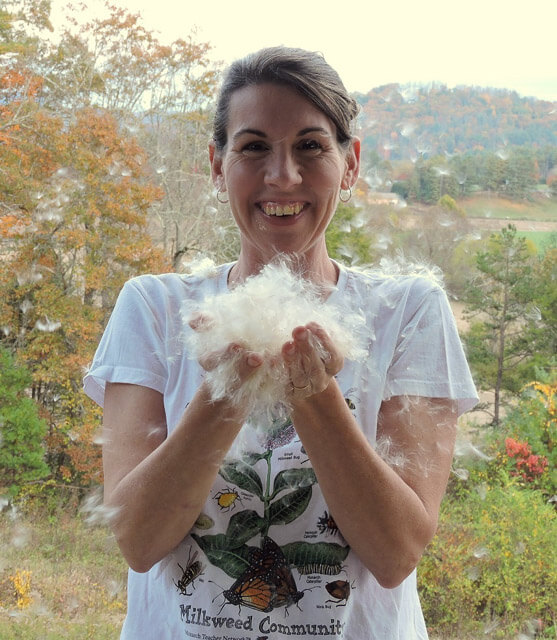
Kim Bailey, owner of Milkweed Meadows Farm, has raised thousands of monarchs. One spring, she raised 400 monarchs at once! I asked if she ever tired of watching their transformation:
“I can’t imagine watching monarch metamorphosis could ever get old, especially seeing the larva shedding its skin to reveal the pupa underneath or watching the butterfly emerging from the chrysalis and expanding its wings. I now give more caterpillars and chrysalides away than I raise myself, but getting to share this experience with others is what I find most rewarding. Robert Brault wrote ‘Why try to explain miracles to your kids when you can just have them plant a garden?’ Raising butterflies is a lot like that.”
Kim and I sat down to talk about gardening for pollinators. Afterwards, the boys joined us to explore her farm and release adult butterflies. I’m excited to share the visit with you.
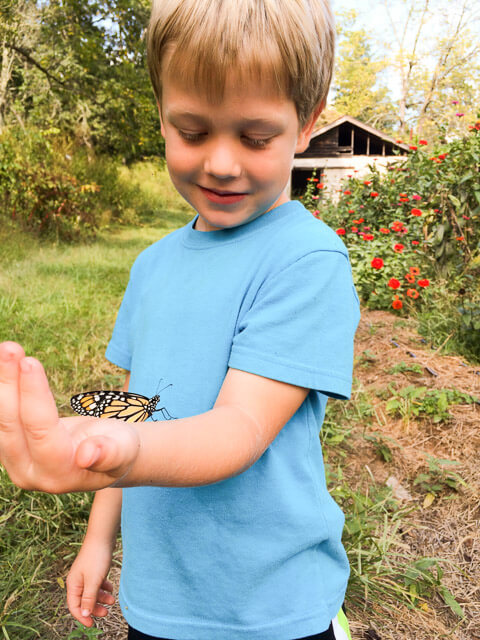
We covered LOTS of ground, so I’ve broken it down into four parts:
- My interview with Kim – her journey to farming, this season’s successes and failures, and what she’d do if starting from scratch
- A virtual tour of her gardens
- Kim’s favorite monarch resources
- Top 10 mind-blowing things I’ve learned about monarchs!
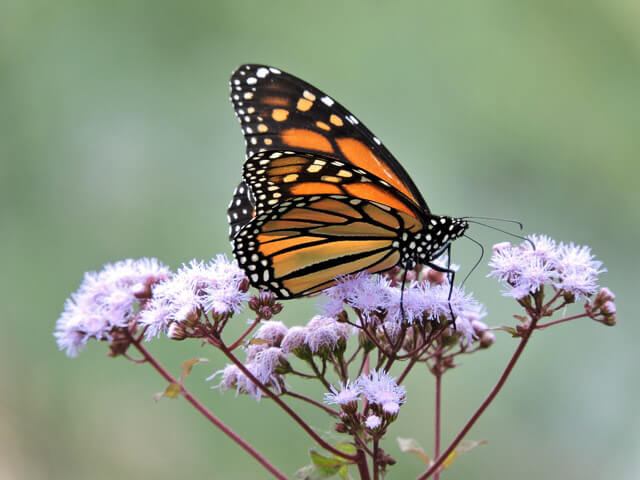
Part 1: An Interview with Kim
Amy: Tell us a little about yourself and your garden.
Kim: I’ve worked as an environmental educator for over 20 years. From the beginning, when I was at camps and nature centers, it always bugged me that kids had to get on a bus and come to us for their field trip. I felt like they got the idea that nature is a place that you visit, that it’s not everywhere.
So, I got information together about creating outdoor classrooms and gardens to send back with the teachers. They could have a field trip right outside their classroom door.
As part of the Georgia Council of Outdoor Learning, I’d help teachers find ways to learn outside with their students. Through that, I started doing pollinator gardening.
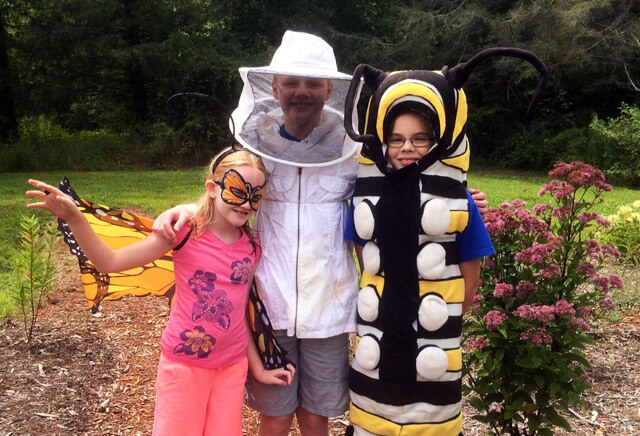
Then, I learned more about farm-to-school and vegetable gardens. I got really interested and transitioned to do more farming.
I could never not be an educator, so now, I have a hybrid job. I work half-time for the Captain Planet Foundation doing school gardens, lesson plans, and teacher workshops. And half-time, I’m farming and growing seed for Sow True Seed. And then I do my volunteer jobs with the Henderson County Beekeepers Association and Bee City USA. So, I’m even busier than before!
What are you growing here on your farm?
I started with what I knew best, the wildflowers. I was just doing it because I wanted to.
Around that time, monarchs were in the news more because of population decline. People started noticing and there became funding to do restoration work, so milkweed seeds became more valuable. Not a lot of people were growing milkweed on purpose. Usually they pull it out! So, I was able to sell milkweed to Sow True Seed.
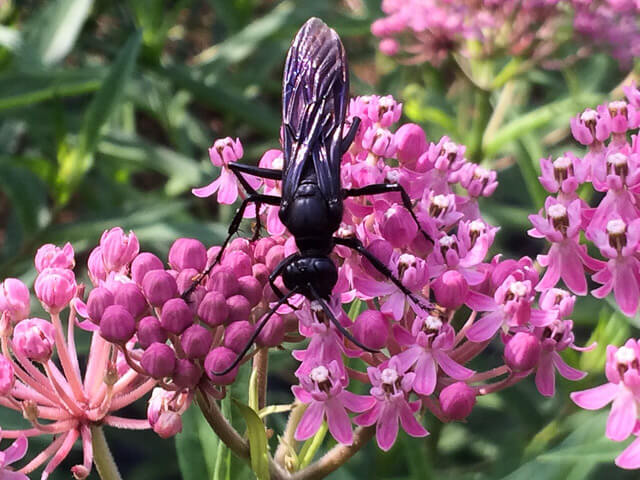
I started with that, and they wanted to know if [I would] grow seeds for their heirloom vegetables. Their catalog is mainly open-pollinated, heirloom vegetables.
Last year, I did Bertie’s Best Greasy Beans and that went really well. This year, I’m doing that one again and I’m growing red ruffled pimiento peppers and silver queen okra (and I know that’s the name of a corn, but it’s also the name of an okra) and Piggott peas.
Then…there’s the Pawpaw Patch.
Kim had a huge smile on her face when she said this. 🙂 She’d just returned from the International Pawpaw Conference in Frankfort, Kentucky, and her enthusiasm for the underappreciated fruit tree was contagious. She even treated the boys and me to a pawpaw tasting!
Yes! Tell me about your pawpaws…
I started growing pawpaw because it’s a host plant for a zebra swallowtail. I had never tasted one. I knew they made an edible fruit, but I had never found any in the woods. So, the first time I tried the pawpaw fruit, I decided, ‘Okay, now I need to grow these not just for the butterflies, but for me!’ I actually planted the pawpaw patch two years before we broke ground on our house.
Why do you garden?
For monarchs, I really got into it in 2000. We had Dr. Karen Oberhauser from University of Minnesota do a training in Georgia.
I planted milkweed that year and actually got monarchs on it. Probably the day I planted it! I had all these caterpillars, we had this training coming up, and I was running out of milkweed fast. So, I brought caterpillars [to the workshop] and Karen provided milkweed. I remember the very first time I saw a caterpillar form its J and pupate because it happened in that workshop.
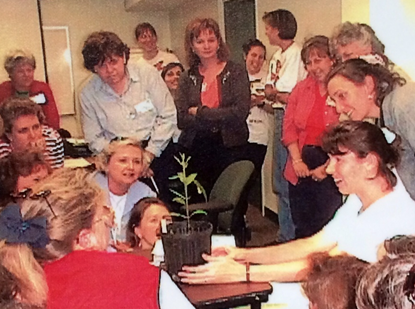
Something Karen said stuck with me. She said you could teach a lot of these same concepts using mealworms, but it’s just not the same.
Monarchs? There’s something magic about them. If you can get a kid hooked with a monarch, it’s a gateway organism to the rest of nature. That’s why I’ve done so much with monarchs–they have that power.
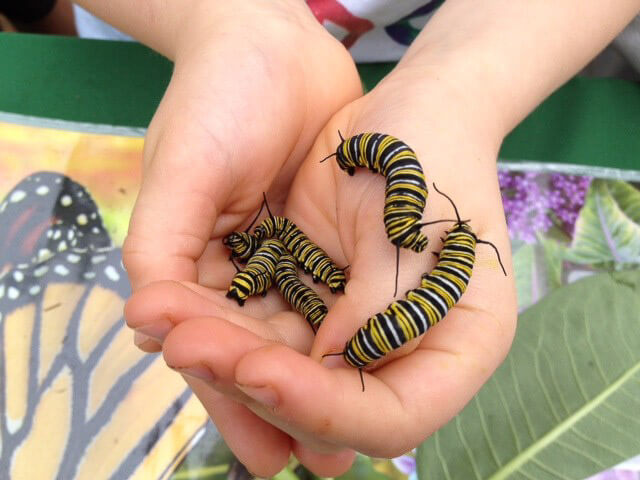
Can you tell us about a success you’ve had in the garden this season?
I was really worried I wasn’t going to get monarchs this spring. I didn’t get them in April like the year before and the window of time for Mexican migrants was almost past.
Then it was Mother’s Day weekend. I saw a female monarch, and I searched all my milkweed [but found no eggs]. I was like, eight varieties of milkweed and you flew right by?
A week later–it was Friday the 13th–I saw either her again or a different female and she laid the eggs. Friday the 13th’s my lucky day. I did get monarchs this spring. That was a success!
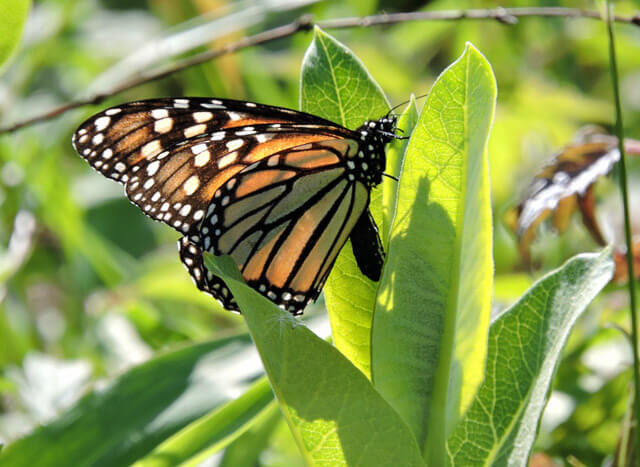
Can you take us the other direction? What’s been your biggest challenge this year?
This was a bad year for the aphids. In the past, I’ve always been able to manage them and just spray them off with the garden hose.
I thought I was being very proactive. I collected praying mantis egg cases, ootheca, and I kept them in the refrigerator all winter. When I saw my very first aphids, I started putting them out. I thought, they are going to be my little army, and they’re gonna take care of those aphids. And the praying mantids worked…for awhile.
Then, the aphids got ahead of them. My caterpillar tunnel was covered with honeyvine milkweed. It smells like pina coladas, and it was beautiful. But within two weeks, while I was out of town, aphids sucked all the juices out and it dropped all of its leaves. It was gone.
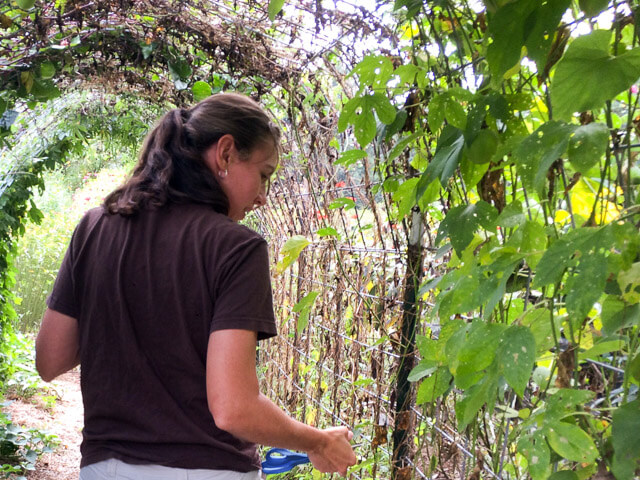
What do you tell yourself in those moments when things aren’t working?
There are times when I just have to let it go. I cannot stay out there with a garden hose two hours a day spraying off aphids.
The plant is resilient. It’ll die back from the aphids, they won’t have anything left to eat, and then the plant will come back from the roots. It’s a cycle. Some years, the aphids are going to be worse than other years. It’ll balance out.
Let’s get specific. When you work with educators to create gardens for monarchs and other pollinators, what are your go-to plants?
If you’re doing a butterfly garden, there’s a 2-2-2 rule.
For your perennial plants, you’ve got to have milkweed and either parsley, dill, fennel, or zizia (golden alexander). That way you get monarchs and black swallowtails.
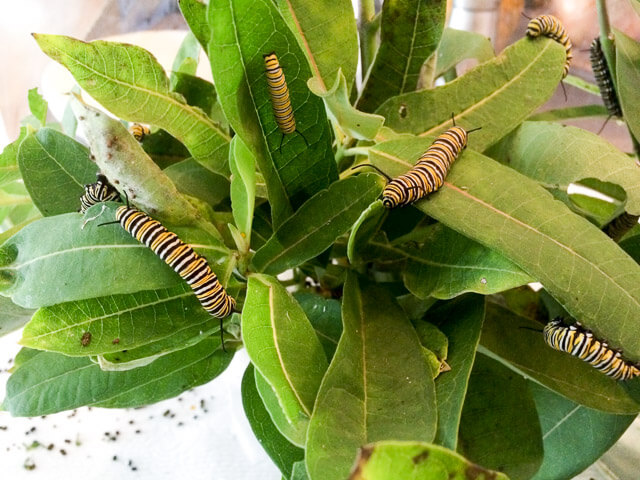
The nice thing about that second one, the parsley group, is that you don’t ever have to worry about having a milkweed emergency. If you ever run out of food, you can go into any grocery store and buy a giant clump of Organic parsley for black swallowtails.
Next, there’s two vines: passionvine and pipevine. Every year, I get gulf fritillaries and variegated fritillaries that lay eggs on passionvine, and pipevine swallowtails that lay eggs on pipevine.
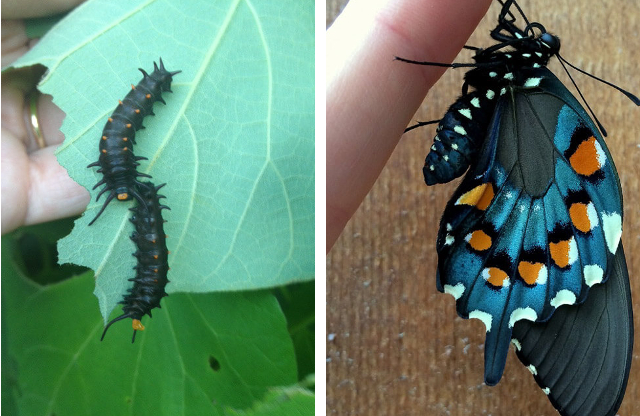
Last, you’ve got two trees or shrubs. One of them would be pawpaw! Even though I have yet to get a zebra swallowtail, one day I will. Then, I like spicebush or sassafras for the spicebush swallowtail. You could do tulip poplar, too, for the tiger swallowtail.
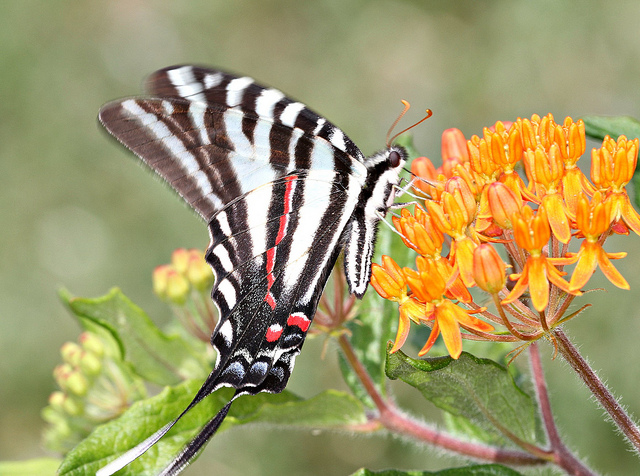
Those are the ones that I plant, and I get butterflies every year. Those are the ones I think people will fi`nd most successful.
If you had to start all over from scratch, what would you do first?
I’d mow the area down and somehow cover it. I’d put cardboard down or you could use the plastic to solarize it. You want to get it clean, so that you can start something new without having what’s already there compete.
And what would you plant first?
The butterfly host plants I’ve already told you about. And then, zinnias, which are not a native plant, but they’re such a great nectar source and they’re just a happy flower. I feel like I’ll always have the zinnias.
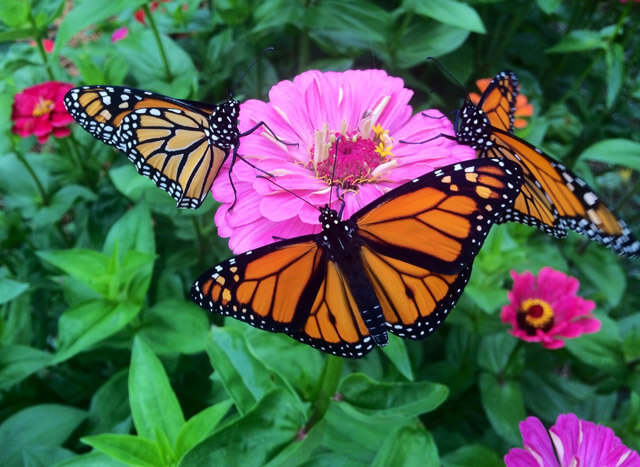
And I love okra–my favorite is Carmine Splendor–and zucchini and tomatoes.
Kim shared a story about growing from scratch just a few years ago…
The very first year I lived here, I had grown everything from seed in Georgia. I thought we were going to move in in April, but by June, I knew we weren’t about to move [because of weather delays]. So, I packed 30 tomato plants in the cab of my truck. They were in double-stacked gallon pots and staked. My husband Jeff said, ‘There’s no way you’re going to fit them in there.’
You don’t tell a gardener who has grown 30 tomato plants, 30 varieties from seed, that these are not going to produce tomatoes. I will find a way!
So, I got them all in and came. I camped out and I planted the tomatoes, the zucchini, the beans. By the time the house was finished and we moved in August, I had my garden.
Then, we headed outside with her two Carolina dogs, Mason and Ellie, to explore.
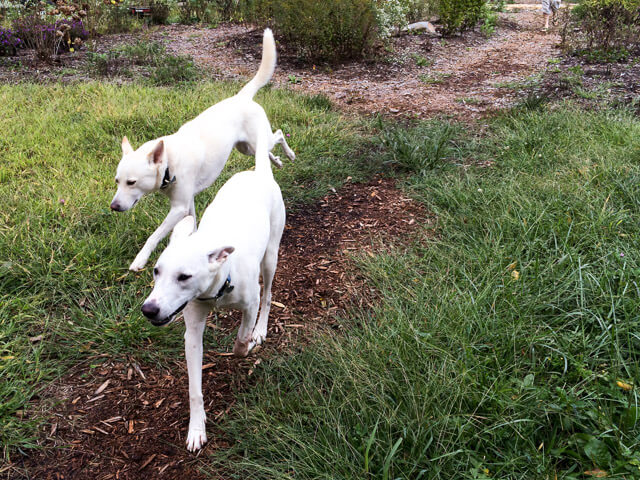
Part 2: Exploring A Garden Full of Color and Flight
After the interview, Kim and I walked down wide rows of milkweed, passionvine, and pipevine for caterpillars; zinnias and cosmos for nectaring butterflies; and the heirloom vegetables she grows for seed and food. We paused inside her caterpillar tunnel to taste a passion fruit. Her garden is a riot of color and flight.
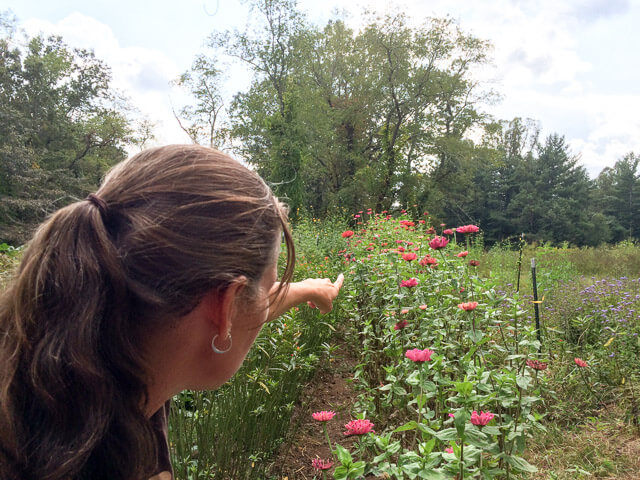
Kim manages weeds using plastic and cardboard mulch around her plantings. Drip-tape irrigation, laid when she created the rows, makes it easy to water the garden when necessary.
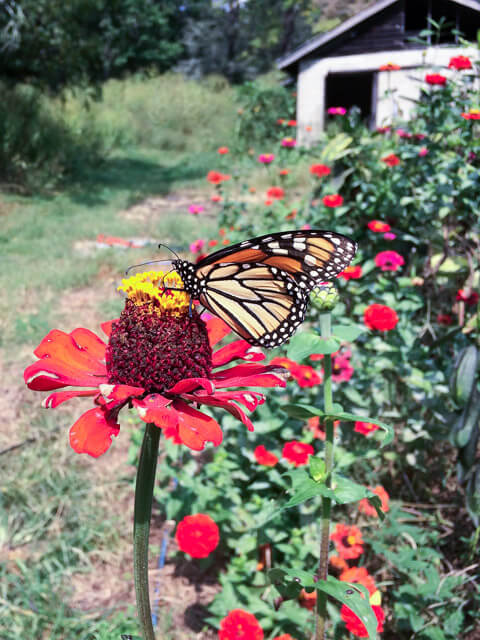
An old milking barn sits on one end. Either side is bordered by perennial beds of strawberries and asparagus. On the far end, two white boxes signal another of Kim’s favorite pollinators–bees!
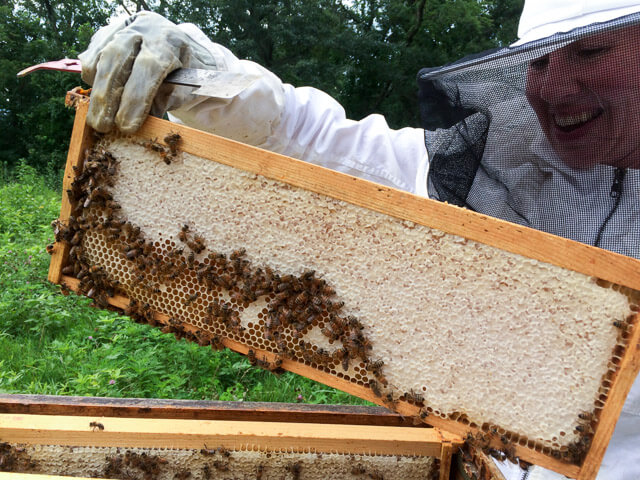
The boys joined us to help release some newly emerged butterflies. First, we explored more with Kim checking milkweed for eggs and caterpillars. She has second sense for monarch eggs, spotting them easily as she tilts the stems to check under leaves.
We found two that day, hopefully the last few eggs of an older female. This time of year, reproduction in new females should be suspended. Biologists call this reproductive diapause. The monarchs should be headed to Mexico. They know it’s time to migrate because of three signals: length of day, temperature, and condition of the milkweed.
Kim clipped off the egg-bearing leaves and carried them inside for safe-keeping. She returned with four fresh adults ready for release.
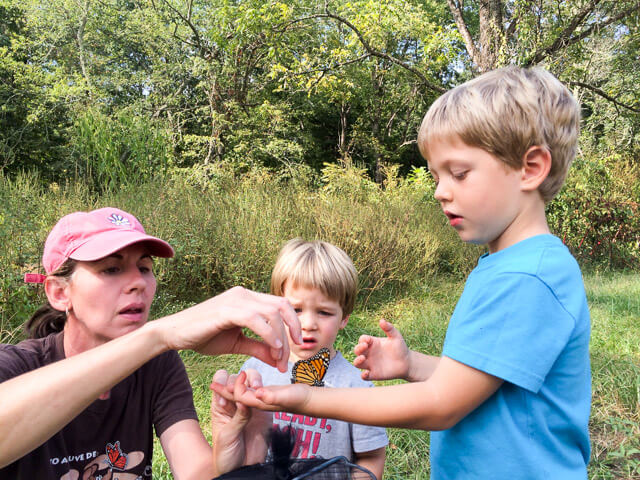
I love the looks on their faces after releasing the first one!
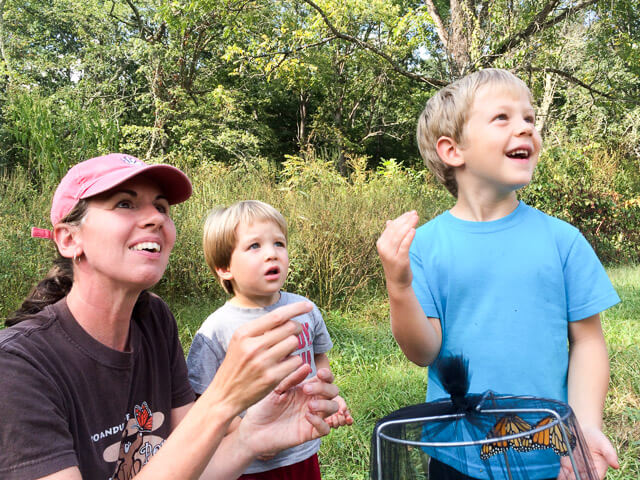
Kim also showed us the Pawpaw Patch. We hiked through a few hundred feet of forest to a sloping field full of milkweed, goldenrod, and brambles. Near the top of the slope, the field was mown close under two rows of young pawpaws.
She’s making room to plant more trees soon, and she can imagine hosting a dinner between the rows of her orchard in the years to come. I can imagine it, too, with zebra swallowtails floating through the pawpaws!
Part 3: Butterfly Resources
Kim shared links to some of her favorite resources about monarchs:
- Background information about monarchs from Monarch Watch
- How to Raise Monarch Butterflies: A Step-by-Step Guide for Kids – a great book
- Flight of the Butterflies – an amazing movie, originally created for IMAX theatres
- Rearing tips from Monarch Joint Venture, Monarch Lab, and Monarch Butterfly Garden.
- Growing Up Butterfly – A clip from National Geographic showing the monarch life cycle
- A detailed explanation of metamorphosis from Monarch Chaser
- How to tell the difference between male and female monarchs
- The Great Milkweed Germination Test – shows the importance of cold stratification
- Use the Journey North citizen science program to track milkweed emergence and monarch migration, plus submit your own local observations.
- If you’re curious to connect with Kim, you can email her here.

Part 4: 10 Mind-Blowing Monarch Facts
There’s something magical about monarchs. The more I talked with Kim and read about the butterflies, the more amazed I’ve become!
Just how amazing are monarch butterflies? Here are 10 mind-blowing facts about monarchs:
- A female monarch lays around 500 eggs. She usually lays only one egg per milkweed plant. That means plenty of food for the caterpillar!
- It only takes 30 days for monarchs to develop from egg to adults.A first instar caterpillar. Photo: Kim Bailey
- Caterpillars are milkweed-eating machines. They grow at an incredible rate, gaining 2,700 times their original weight! If we could grow that fast, a 6-pound baby would end up weighing about 8 tons—as much as a school bus.
- It’s a dangerous world for caterpillars. Only 1 or 2 out of every 100 eggs survive to become adults.
- Inside the chrysalis, the caterpillar dissolves (literally!) and special cells grow into the wings, heart, antennae, and other body parts of the adult butterfly.
- Most adults live for just a few weeks, drinking nectar, mating, and laying eggs. But in fall, the migrating “super generation” emerges. They’ll live up to nine months!
- Depending on where they start, migrating butterflies can fly up to 3,000 miles!
- Most eastern monarchs funnel into 12 mountain tops in Michoacán in central Mexico for winter. (West of the Rockies, the monarchs overwinter in coastal California.) In Mexican folklore, monarchs are the returning spirits of ancestors. They arrive in early November, just in time for Dia de los Muertos, the Mexican holiday honoring the departed.
- Monarchs migrate north over three to four generations. Sometimes, biologists see five generations. That means the great-great-great-grandchildren make the return flight to Mexico!
- The monarch may be an endangered species. The U.S. Fish and Wildlife Service will decide if it should be officially designated “Endangered.” Their population declined by 80-90% in the last twenty years. Over that time, we’ve lost more than 150 million acres of monarch habitat. Winter forests have been damaged by bark beetles and illegal logging. Summer breeding grounds have disappeared with the increased use of milkweed-killing herbicides in large-scale agriculture fields.
Ready to garden for monarchs and other pollinators?
If you’ve read this far, I’m guessing your answer is YES!
The resources above are a great place to start learning more about monarch conservation. To learn more about pollinators in general, Xerces Society and Pollinator Partnership are also great resources.
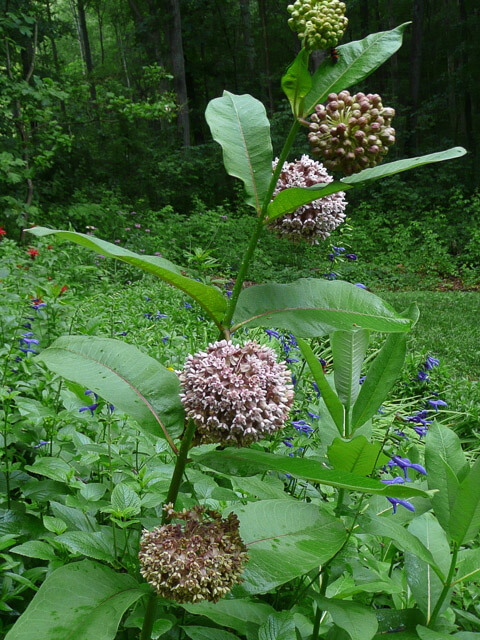
You can buy Kim’s milkweed seed through Sow True Seed (or find a milkweed seeds for your region through Monarch Watch’s milkweed market or the Xerces milkweed-seed-finder.)
When monarchs arrive in your area, look for monarch eggs and caterpillars to adopt. It is fascinating, and you can help give those monarchs a better chance of becoming adults.
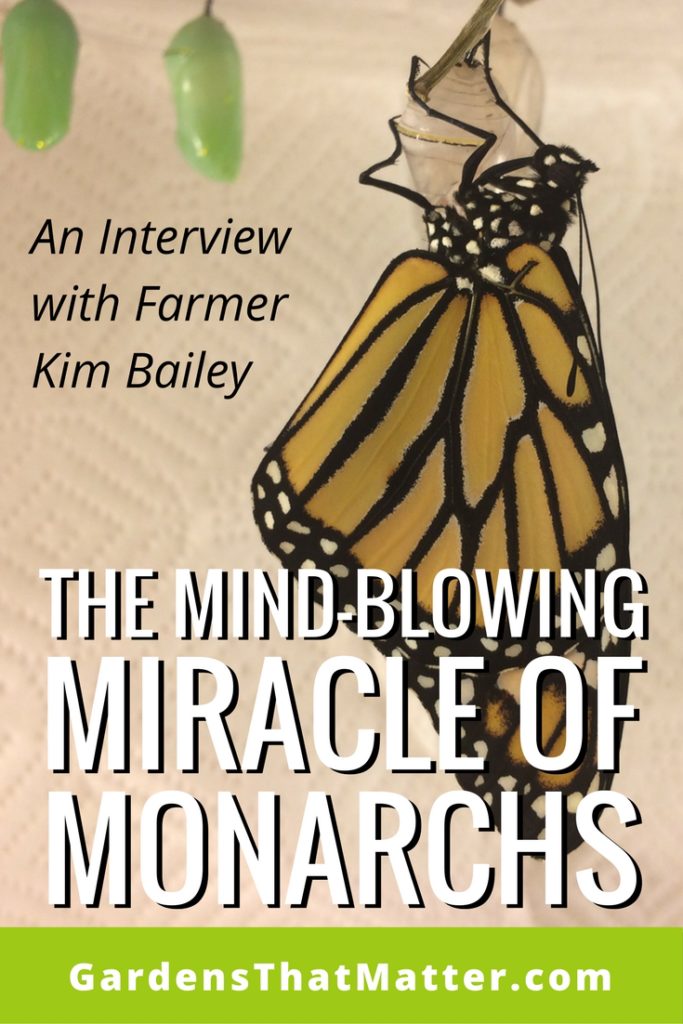
Your Turn
Perhaps you’re already growing food for pollinators in your garden. We’d love to hear about it in the comments below.
What are your favorite pollinator plants to grow? What plants would you like to add next season?
Do you grow for pollinators in a special area, or like Kim, do you plant them throughout your gardens?
If you have any questions about monarchs or pollinator gardening, feel free to ask them below, too. Thank you for sharing your voice!

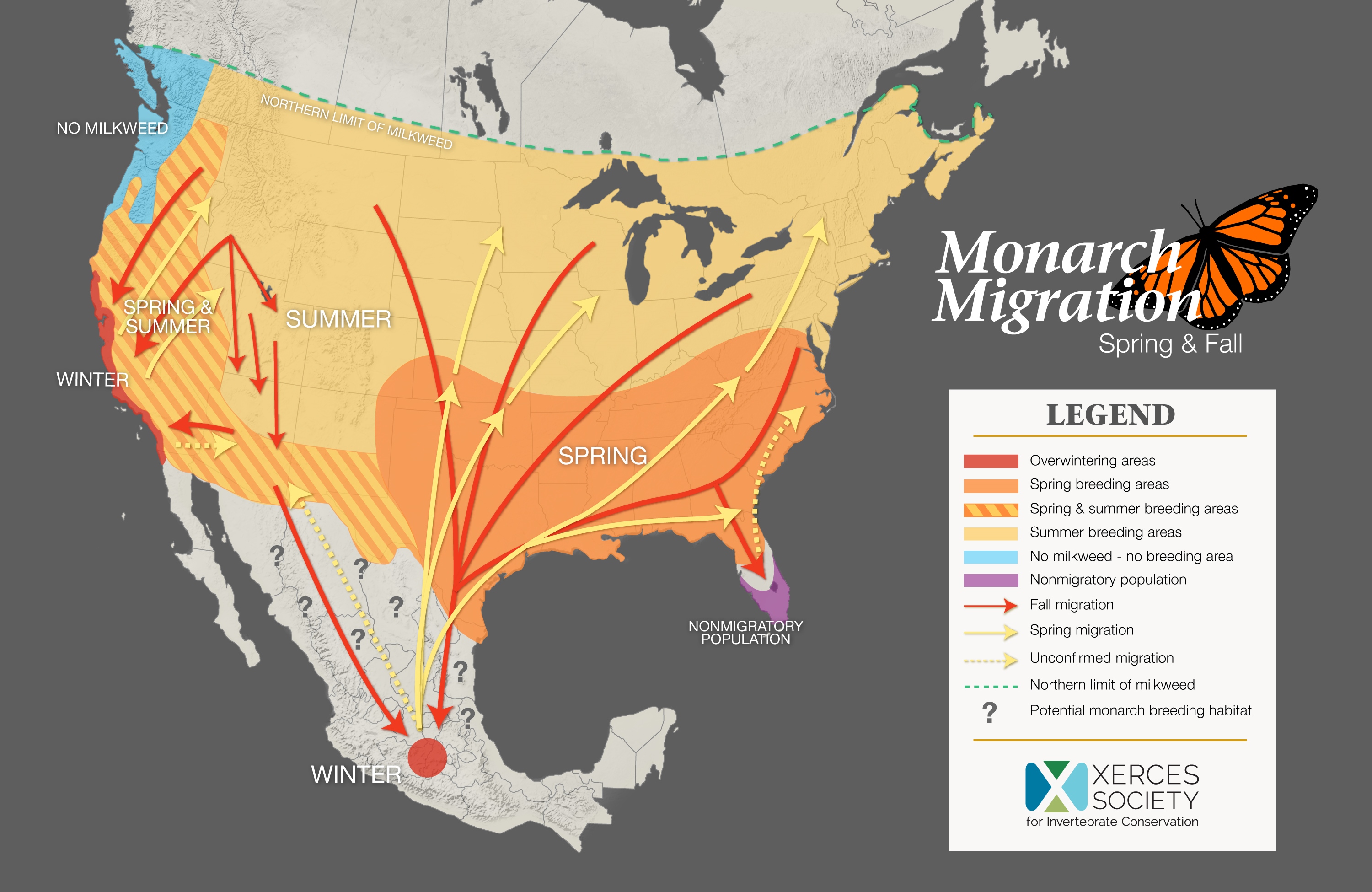
What a fantastic site! Love it!
Thanks, David!
Hooray for the truly miraculous and mind-blowing Farmer Kim!